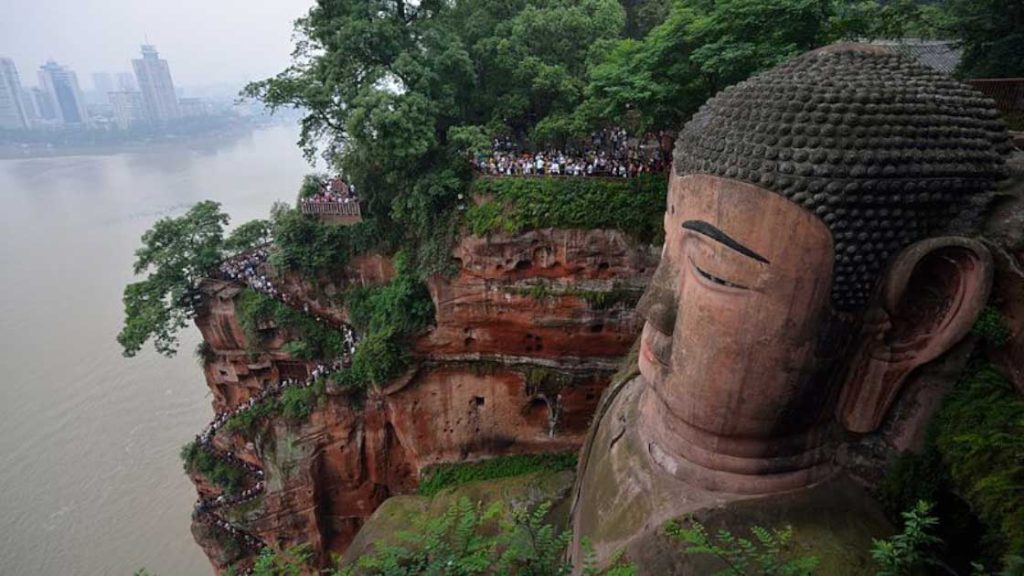For thousands of years, people have been building religious monuments. This is normally done for one of two reasons, to either provide followers with a place to worship their god/gods or as a way to keep said god happy.
One of the most impressive of these monuments still standing today is the Leshan Giant Buddha in China. In remarkably good condition today it is the tallest Buddha in the world. More surprisingly it has saved the lives of countless sailors over the years who have sailed under its gaze. Is it the Buddha’s magical blessing that has saved them or something more practical?
What is the Leshan Buddha?
The Leshan Buddha is the tallest giant Buddha statue in the world, measuring an impressive 71 meters (230 feet) high, half as high again as the Statue of Liberty in New York harbor. It dates back to the 8th century AD during the Tang dynasty and was carved out of the Cretaceous red bed sandstone that makes up the hillside of Xijou Peak.
The Leshan Buddha can be found on Lingyun Mountain’s Qifeng Peak overlooking the junction of the Minijang, Qingyi, and Dadu rivers. It is full of other important historical sites such as cliff tombs and dwellings. The statue and its surrounding area were listed as a UNESCO World Heritage Site in 1996.
For a carving that is over a thousand years old, the Buddha is still in pretty good shape. This is largely thanks to the surprisingly advanced drainage system that can be found behind the Buddha’s head. It features several hidden gutters and channels which run through the Buddha’s hair, collar, upper body, and the back of his ears which carry out rainwater, keeping the inner areas dry.

Up until recently, the system did a good job of protecting the Buddha. Sadly in recent times, the Buddha has seen increased levels of degradation due to the high degree of development in the region. Pollution pumped into the environment from these developments has taken its toll on the Buddha.
The creation of the Leshan Buddha is largely down to one man, a Chinese Buddhist monk by the name of Hai Tong. The three rivers the Leshan Buddha overlooks were incredibly turbulent and every year many of the ships that sailed their waters sank. Hai Tong believed that building a statue of Buddha would calm the dangerous waters.
Why? Well, the Leshan Buddha was carved as a representation of the Maitreya Buddha. In Buddhist teachings, the Maitreya Buddha is the fifth and final Buddha.
It is believed this Buddha will lead all sentient life to achieve enlightenment. As essentially the most powerful or “ultimate Buddha”, Hai Tong hoped that a statue of him that looked over the convergence of the three rivers would protect the sailors.
Despite his noble goal, things did not go smoothly for Hai Tong. Initially, he traveled the area asking for donations so he might begin his work. As construction started the local government arrived. They felt Hai Tong was making them look bad and accused him of being a con man. They threatened him and his funding was lost.
It is said these threats led Hai Tong to gouge out his own eyes in a show of his piety and sincerity. This led to his funding being reinstated but sadly Hai Tong died before the statue could be completed.
After his death, the project once again ran out of funding and the Buddha was left unfinished below the shoulders. Several years later construction restarted after a local official called Zhangchou Jianxiong offered his financial support. With this funding, Hai Tong’s disciples managed to complete down to the Buddha’s knees before once again losing funding.
Around 70 years later construction once again restarted after another new donor, Jiedushi Wei Gao offered the needed money. Hai Tong’s disciples finally finished the Buddha in around 803 AD.
Does the Buddha Work?
Perhaps the most amazing thing about the Leshan Buddha is that it really did have a major effect on the Minijang, Qingyi, and Dadu Rivers in the centuries following Hai Tong’s death. The lives of countless sailors were indeed saved.
How is this so? Well, there are two possible reasons. Believers of course point to Hai Tong’s work and claim that the Buddha works. Under his careful gaze, the waters of the rivers calmed, making them much less dangerous. Hai Tong’s piety and sincerity were rewarded and a great miracle was enacted.

There is also a practical reason the Buddha worked. The carving of the Buddha required a huge amount of stone and rubble to be carved away from the cliff side. This rubble was then deposited into the rivers below. The sheer volume of rock dumped into the river altered the current and calmed the once choppy waters.
So Hai Tong really was a miracle worker. His construction of a giant Buddha did exactly what he set out to do, calm dangerous waters and save lives. Whether or not Hai Tong knew that the construction of the Buddha would have a physical effect on the rivers’ waters is anyone’s guess.
The fact that the Leshan Buddha features such an intricate and advanced drainage system implies that perhaps Hai Tong was not just a devout monk but a gifted engineer as well. It is likely he probably guessed all the rubble being dumped into the river would settle the waters.
He may not have lived to see the Buddha’s completion but his legacy lives on. The Buddha has been damaged by war and rebuilt many times over the years but has always been restored to glory. Hopefully, it will survive its current war with pollution so it might be here to meet the true Maitreya Buddha someday.
Top Image: The Leshan Buddha is the tallest monolithic Buddha statue in the world. Source: Weiming / Adobe Stock.